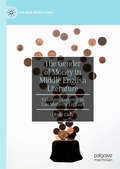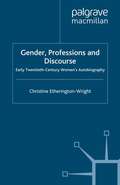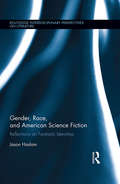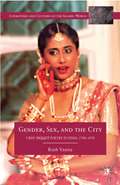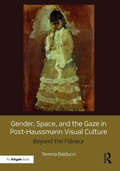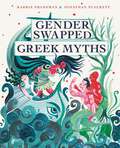- Table View
- List View
Gender, Nation and the Formation of the Twentieth-century Mexican Literary Canon
by Sarah E. Bowskill"The post-revolutionary Mexican literary canon was formed by cultural and political elites who sought to identify and reward those novels which would best represent the new nation. Reviewers found what they were looking for in Gregorio Lopez y Fuentes's El indio (1935) for example, but not in Consuelo Delgados's Yo tambien, Adelita (1936). This groundbreaking study provides a fresh perspective on canon formation by uncovering the circumstances and readings which produced a male-dominated Mexican literary canon."
Gender, Nation and the Formation of the Twentieth-century Mexican Literary Canon
by Sarah E. Bowskill"The post-revolutionary Mexican literary canon was formed by cultural and political elites who sought to identify and reward those novels which would best represent the new nation. Reviewers found what they were looking for in Gregorio Lopez y Fuentes's El indio (1935) for example, but not in Consuelo Delgados's Yo tambien, Adelita (1936). This groundbreaking study provides a fresh perspective on canon formation by uncovering the circumstances and readings which produced a male-dominated Mexican literary canon."
The Gender of Modernity
by Rita FelskiIn an innovative and invigorating exploration of the complex relations between women and the modern, Rita Felski challenges conventional male-centered theories of modernity. She also calls into question those feminist perspectives that have either demonized the modern as inherently patriarchal, or else assumed a simple opposition between men’s and women’s experiences of the modern world. Combining cultural history with cultural theory, and focusing on the fin de siècle, Felski examines the gendered meanings of such notions as nostalgia, consumption, feminine writing, the popular sublime, evolution, revolution, and perversion. Her approach is comparative and interdisciplinary, covering a wide variety of texts from the English, French, and German traditions: sociological theory, realist and naturalist novels, decadent literature, political essays and speeches, sexological discourse, and sentimental popular fiction. Male and female writers from Simmel, Zola, Sacher-Masoch, and Rachilde to Marie Corelli, Wilde, and Olive Schreiner come under Felski’s scrutiny as she exposes the varied and often contradictory connections between femininity and modernity. Seen through the lens of Felski’s discerning eye, the last fin de siècle provides illuminating parallels with our own. And Felski’s keen analysis of the matrix of modernism offers needed insight into the sense of cultural crisis brought on by postmodernism.
The Gender of Money in Middle English Literature: Value and Economy in Late Medieval England (The New Middle Ages)
by Diane CadyThe Gender of Money in Middle English Literature: Value and Economy in Late Medieval England explores the vital and under-examined role that gender plays in the conceptualization of money and value in a period that precedes and shapes what we now recognize as the discipline of political economy. Through readings of a range of late Middle English texts, this book demonstrates the ways in which gender ideology provided a vocabulary for articulating fears and fantasies about money and value in the late Middle Ages. These ideas inform beliefs about money and value in the West, particularly in realms that are often seen as outside the sphere of economy, such as friendship, love and poetry. Exploring the gender of money helps us to better understand late medieval notions of economy, and to recognize the ways in which gender ideology continues to haunt our understanding of money and value, albeit often in occluded ways.
Gender, Otherness, and Culture in Medieval and Early Modern Art (PDF)
by Carlee A. Bradbury Michelle Moseley-ChristianThis collection examines gender and Otherness as tools to understand medieval and early modern art as products of their social environments. The essays, uniting up-and-coming and established scholars, explore both iconographic and stylistic similarities deployed to construct gender identity. The text analyzes a vast array of medieval artworks, including Dieric Bouts’s Justice of Otto III, Albrecht Dürer’s Feast of the Rose Garland, Rembrandt van Rijn’s Naked Woman Seated on a Mound, and Renaissance-era transi tombs of French women to illuminate medieval and early modern ideas about gender identity, poverty, religion, honor, virtue, sexuality, and motherhood, among others.
Gender (Transitions)
by Claire ColebrookWhy has Western thought been so persistent in its organisation of human bodies, and other categories, in terms of the binary opposition male and female? Is gender nothing more than an ideology, or does it have its basis in sexual difference? This invaluable introductory guide offers a clear overview of the concept, and problem, of gender. Claire Colebrook places the term in its historical contexts and traces its development from the Enlightenment to the present, before moving on to the evolution of the concept of gender from within the various stances of feminist criticism, and exploring recent developments in queer theory and post-feminism. Close analysis of key literary texts, including Frankenstein, Paradise Lost and A Midsummer Night's Dream, shows how specific styles of literature enable reflection on gender.
Gender, Performance, and Authorship at the Abbey Theatre
by Elizabeth Brewer RedwineGender, Performance, and Authorship at the Abbey Theatre argues for a reconsideration of authorship at the Abbey Theatre. The actresses who performed the key roles at the Abbey contributed original ideas, language, stage directions, and revisions to the theatre's most renowned performances and texts, and this study asks that we consider the role of actresses in the development of these plays. Plays that have been historically attributed to W. B. Yeats and J. M. Synge have complicated histories, and the neglect of these women's contributions over the past century reflects power dynamics that privilege male, Anglo Irish writers over the contributions of working class actresses. The study asks that readers consider the importance of past performance in the creation of written text. Yeats began his earliest plays performing with and writing for Laura Armstrong, a young woman who was a precursor to Maud Gonne in her irreverent challenge to traditional gender roles. After writing his first plays and poems for Armstrong, Yeats met Gonne and developed two Cathleen plays, The Countess Cathleen and Cathleen ni Houlihan, for her to perform, beginning a lifetime of fruitful argument between the two writers about how Ireland should appear onstage. The book then turns to Synge's work with Molly Allgood in creating The Playboy of the Western World and Molly's contributions to Synge's Deirdre of the Sorrows. A section on Yeats's Deirdre shows the contributions of Lady Gregory and the play's performers. The book ends with a reconsideration of Abbey actress Sara Allgood's performances in British and American film as she brought her earliest work in the pre-Abbey tableau movement to American audiences in the 1940s, in ways that challenged ideas of Irishness, American identity, and aging women on screen.
Gender, Performance, and Authorship at the Abbey Theatre
by Elizabeth Brewer RedwineGender, Performance, and Authorship at the Abbey Theatre argues for a reconsideration of authorship at the Abbey Theatre. The actresses who performed the key roles at the Abbey contributed original ideas, language, stage directions, and revisions to the theatre's most renowned performances and texts, and this study asks that we consider the role of actresses in the development of these plays. Plays that have been historically attributed to W. B. Yeats and J. M. Synge have complicated histories, and the neglect of these women's contributions over the past century reflects power dynamics that privilege male, Anglo Irish writers over the contributions of working class actresses. The study asks that readers consider the importance of past performance in the creation of written text. Yeats began his earliest plays performing with and writing for Laura Armstrong, a young woman who was a precursor to Maud Gonne in her irreverent challenge to traditional gender roles. After writing his first plays and poems for Armstrong, Yeats met Gonne and developed two Cathleen plays, The Countess Cathleen and Cathleen ni Houlihan, for her to perform, beginning a lifetime of fruitful argument between the two writers about how Ireland should appear onstage. The book then turns to Synge's work with Molly Allgood in creating The Playboy of the Western World and Molly's contributions to Synge's Deirdre of the Sorrows. A section on Yeats's Deirdre shows the contributions of Lady Gregory and the play's performers. The book ends with a reconsideration of Abbey actress Sara Allgood's performances in British and American film as she brought her earliest work in the pre-Abbey tableau movement to American audiences in the 1940s, in ways that challenged ideas of Irishness, American identity, and aging women on screen.
Gender, Pregnancy and Power in Eighteenth-Century Literature: The Maternal Imagination (Palgrave Studies in Literature, Science and Medicine)
by Jenifer BuckleyThis book reveals the cultural significance of the pregnant woman by examining major eighteenth-century debates concerning separate spheres, man-midwifery, performance, marriage, the body, education, and creative imagination. Exploring medical, economic, moral, and literary ramifications, this book engages critically with the notion that a pregnant woman could alter the development of her foetus with the power of her thoughts and feelings. Eighteenth-century authors sought urgently to define, understand and control the concept of maternal imagination as they responded to and provoked fundamental questions about female intellect and the relationship between mind and body. Interrogating the multiple models of maternal imagination both separately and as a holistic set of socio-cultural components, the author uncovers the discourse of maternal imagination across eighteenth-century drama, popular print, medical texts, poetry and novels. This overdue rehabilitation of the pregnant woman in literature is essential reading for scholars of the eighteenth century, gender and literary history.
Gender, Professions and Discourse: Early Twentieth-Century Women's Autobiography
by C. Etherington-WrightAnalyzing ninety professional women's autobiographies from 1900-1920, the first part of this book concentrates on the endeavours of groups such as headmistresses, doctors, nurses, artists and writers to record their own lives, while the second part examines frontispiece photos, prefatory marginalia and the role of silences in autobiography.
Gender Protest and Same-Sex Desire in Antebellum American Literature: Margaret Fuller, Edgar Allan Poe, Nathaniel Hawthorne, and Herman Melville
by David GrevenExpanding our understanding of the possibilities and challenges inherent in the expression of same-sex desire before the Civil War, David Greven identifies a pattern of what he calls ’gender protest’ and sexual possibility recurring in antebellum works. He suggests that major authors such as Margaret Fuller, Edgar Allan Poe, Herman Melville, and Nathaniel Hawthorne consciously sought to represent same-sex desire in their writings. Focusing especially on conceptions of the melancholia of gender identification and shame, Greven argues that same-sex desire was inextricably enmeshed in scenes of gender-role strain, as exemplified in the extent to which The Narrative of Arthur Gordon Pym depicts masculine identity adrift and in disarray. Greven finds similarly compelling representations of gender protest in Fuller’s exploration of the crisis of gendered identity in Summer on the Lakes, in Melville’s representation of Redburn’s experience of gender nonconformity, and in Hawthorne’s complicated delineation of desire in The Scarlet Letter. As Greven shows, antebellum authors not only took up the taboo subjects of same-sex desire and female sexuality, but were adept in their use of a variety of rhetorical means for expressing the inexpressible.
Gender Protest and Same-Sex Desire in Antebellum American Literature: Margaret Fuller, Edgar Allan Poe, Nathaniel Hawthorne, and Herman Melville
by David GrevenExpanding our understanding of the possibilities and challenges inherent in the expression of same-sex desire before the Civil War, David Greven identifies a pattern of what he calls ’gender protest’ and sexual possibility recurring in antebellum works. He suggests that major authors such as Margaret Fuller, Edgar Allan Poe, Herman Melville, and Nathaniel Hawthorne consciously sought to represent same-sex desire in their writings. Focusing especially on conceptions of the melancholia of gender identification and shame, Greven argues that same-sex desire was inextricably enmeshed in scenes of gender-role strain, as exemplified in the extent to which The Narrative of Arthur Gordon Pym depicts masculine identity adrift and in disarray. Greven finds similarly compelling representations of gender protest in Fuller’s exploration of the crisis of gendered identity in Summer on the Lakes, in Melville’s representation of Redburn’s experience of gender nonconformity, and in Hawthorne’s complicated delineation of desire in The Scarlet Letter. As Greven shows, antebellum authors not only took up the taboo subjects of same-sex desire and female sexuality, but were adept in their use of a variety of rhetorical means for expressing the inexpressible.
Gender, Race, and American Science Fiction: Reflections on Fantastic Identities (Routledge Interdisciplinary Perspectives on Literature)
by Jason HaslamThis book focuses on the interplay of gender, race, and their representation in American science fiction, from the nineteenth-century through to the twenty-first, and across a number of forms including literature and film. Haslam explores the reasons why SF provides such a rich medium for both the preservation of and challenges to dominant mythologies of gender and race. Defining SF linguistically and culturally, the study argues that this mode is not only able to illuminate the cultural and social histories of gender and race, but so too can it intervene in those histories, and highlight the ruptures present within them. The volume moves between material history and the linguistic nature of SF fantasies, from the specifics of race and gender at different points in American history to larger analyses of the socio-cultural functions of such identity categories. SF has already become central to discussions of humanity in the global capitalist age, and is increasingly the focus of feminist and critical race studies; in combining these earlier approaches, this book goes further, to demonstrate why SF must become central to our discussions of identity writ large, of the possibilities and failings of the human —past, present, and future. Focusing on the interplay of whiteness and its various 'others' in relation to competing gender constructs, chapters analyze works by Nathaniel Hawthorne, Mary E. Bradley Lane, Edgar Rice Burroughs, Philip Francis Nowlan, George S. Schuyler and the Wachowskis, Frank Herbert, William Gibson, and Octavia Butler. Academics and students interested in the study of Science Fiction, American literature and culture, and Whiteness Studies, as well as those engaged in critical gender and race studies, will find this volume invaluable.
Gender, Race, and American Science Fiction: Reflections on Fantastic Identities (Routledge Interdisciplinary Perspectives on Literature)
by Jason HaslamThis book focuses on the interplay of gender, race, and their representation in American science fiction, from the nineteenth-century through to the twenty-first, and across a number of forms including literature and film. Haslam explores the reasons why SF provides such a rich medium for both the preservation of and challenges to dominant mythologies of gender and race. Defining SF linguistically and culturally, the study argues that this mode is not only able to illuminate the cultural and social histories of gender and race, but so too can it intervene in those histories, and highlight the ruptures present within them. The volume moves between material history and the linguistic nature of SF fantasies, from the specifics of race and gender at different points in American history to larger analyses of the socio-cultural functions of such identity categories. SF has already become central to discussions of humanity in the global capitalist age, and is increasingly the focus of feminist and critical race studies; in combining these earlier approaches, this book goes further, to demonstrate why SF must become central to our discussions of identity writ large, of the possibilities and failings of the human —past, present, and future. Focusing on the interplay of whiteness and its various 'others' in relation to competing gender constructs, chapters analyze works by Nathaniel Hawthorne, Mary E. Bradley Lane, Edgar Rice Burroughs, Philip Francis Nowlan, George S. Schuyler and the Wachowskis, Frank Herbert, William Gibson, and Octavia Butler. Academics and students interested in the study of Science Fiction, American literature and culture, and Whiteness Studies, as well as those engaged in critical gender and race studies, will find this volume invaluable.
Gender Roles and Political Contexts in Cold War Spy Fiction (Crime Files)
by Sian MacArthurThis book analyses the gender roles and political contexts of spy fiction narratives published during the years of the Cold War. It offers an introduction to the development of spy fiction both in England and in the United States and explores the ways in which issues such as the atomic bomb, double agents, paranoia, propaganda and megalomania manifest themselves within the genre. The book examines the ongoing marginalization of women within spy fiction texts, exploring the idea that this unique period in global history is responsible for the active promotion and celebration of masculinity and male superiority. From James Bond to Jason Bourne, the book evaluates the ongoing enforcement of patriarchal ideas and oppressions that, in the name of national security and patriotic duty, have contributed to the development of a genre in which discrimination and bias continue to dominate.
Gender, Sex, and the City: Urdu Rekhti Poetry in India, 1780-1870 (Literatures and Cultures of the Islamic World)
by R. VanitaExplores the urban, cosmopolitan sensibilities of Urdu poetry written in the late eighteenth and early nineteenth centuries in Lucknow. Ruth Vanita analyzes Rekhti, a type of Urdu poetry distinguished by a female speaker and a focus on women's lives, and shows how it becamea catalyst for the transformation of the ghazal.
Gender, Sexuality, and Material Objects in English Renaissance Verse (Women and Gender in the Early Modern World)
by Pamela S. HammonsAn important contribution to recent critical discussions about gender, sexuality, and material culture in Renaissance England, this study analyzes female- and male-authored lyrics to illuminate how gender and sexuality inflected sixteenth- and seventeenth-century poets' conceptualization of relations among people and things, human and non-human subjects and objects. Pamela S. Hammons examines lyrics from both manuscript and print collections”including the verse of authors ranging from Robert Herrick, John Donne, and Ben Jonson to Margaret Cavendish, Lucy Hutchinson, and Aemilia Lanyer”and situates them in relation to legal theories, autobiographies, biographies, plays, and epics. Her approach fills a crucial gap in the conversation, which has focused upon drama and male-authored works, by foregrounding the significance of the lyric and women's writing. Hammons exposes the poetic strategies sixteenth- and seventeenth-century English women used to assert themselves as subjects of property and economic agents”in relation to material items ranging from personal property to real estate”despite the dominant patriarchal ideology insisting they were ideally temporary, passive vehicles for men's wealth. The study details how women imagined their multiple, complex interactions with the material world:the author shows that how a woman poet represents herself in relation to material objects is a flexible fiction she can mobilize for diverse purposes. Because this book analyzes men's and women's poems together, it isolates important gendered differences in how the poets envision human subjects' use, control, possession, and ownership of things and the influences, effects, and power of things over humans. It also adds to the increasing evidence for the pervasiveness of patriarchal anxieties associated with female economic agency in a culture in which women were often treated as objects.
Gender, Sexuality, and Material Objects in English Renaissance Verse (Women and Gender in the Early Modern World)
by Pamela S. HammonsAn important contribution to recent critical discussions about gender, sexuality, and material culture in Renaissance England, this study analyzes female- and male-authored lyrics to illuminate how gender and sexuality inflected sixteenth- and seventeenth-century poets' conceptualization of relations among people and things, human and non-human subjects and objects. Pamela S. Hammons examines lyrics from both manuscript and print collections”including the verse of authors ranging from Robert Herrick, John Donne, and Ben Jonson to Margaret Cavendish, Lucy Hutchinson, and Aemilia Lanyer”and situates them in relation to legal theories, autobiographies, biographies, plays, and epics. Her approach fills a crucial gap in the conversation, which has focused upon drama and male-authored works, by foregrounding the significance of the lyric and women's writing. Hammons exposes the poetic strategies sixteenth- and seventeenth-century English women used to assert themselves as subjects of property and economic agents”in relation to material items ranging from personal property to real estate”despite the dominant patriarchal ideology insisting they were ideally temporary, passive vehicles for men's wealth. The study details how women imagined their multiple, complex interactions with the material world:the author shows that how a woman poet represents herself in relation to material objects is a flexible fiction she can mobilize for diverse purposes. Because this book analyzes men's and women's poems together, it isolates important gendered differences in how the poets envision human subjects' use, control, possession, and ownership of things and the influences, effects, and power of things over humans. It also adds to the increasing evidence for the pervasiveness of patriarchal anxieties associated with female economic agency in a culture in which women were often treated as objects.
Gender, Space, and the Gaze in Post-Haussmann Visual Culture: Beyond the Flâneur
by Temma BalducciCharles Baudelaire’s flâneur, as described in his 1863 essay "The Painter of Modern Life," remains central to understandings of gender, space, and the gaze in late nineteenth-century Paris, despite misgivings by some scholars. Baudelaire’s privileged and leisurely figure, at home on the boulevards, underlies theorizations of bourgeois masculinity and, by implication, bourgeois femininity, whereby men gaze and roam urban spaces unreservedly while women, lacking the freedom to either gaze or roam, are wedded to domesticity. In challenging this tired paradigm and offering fresh ways to consider how gender, space, and the gaze were constructed, this book attends to several neglected elements of visual and written culture: the ubiquitous male beggar as the true denizen of the boulevard, the abundant depictions of well-to-do women looking (sometimes at men), the popularity of windows and balconies as viewing perches, and the overwhelming emphasis given by both male and female artists to domestic scenes. The book’s premise that gender, space, and the gaze have been too narrowly conceived by a scholarly embrace of Baudelaire’s flâneur is supported across the cultural spectrum by period sources that include art criticism, high and low visual culture, newspapers, novels, prescriptive and travel literature, architectural practices, interior design trends, and fashion journals.
Gender, Space, and the Gaze in Post-Haussmann Visual Culture: Beyond the Flâneur
by Temma BalducciCharles Baudelaire’s flâneur, as described in his 1863 essay "The Painter of Modern Life," remains central to understandings of gender, space, and the gaze in late nineteenth-century Paris, despite misgivings by some scholars. Baudelaire’s privileged and leisurely figure, at home on the boulevards, underlies theorizations of bourgeois masculinity and, by implication, bourgeois femininity, whereby men gaze and roam urban spaces unreservedly while women, lacking the freedom to either gaze or roam, are wedded to domesticity. In challenging this tired paradigm and offering fresh ways to consider how gender, space, and the gaze were constructed, this book attends to several neglected elements of visual and written culture: the ubiquitous male beggar as the true denizen of the boulevard, the abundant depictions of well-to-do women looking (sometimes at men), the popularity of windows and balconies as viewing perches, and the overwhelming emphasis given by both male and female artists to domestic scenes. The book’s premise that gender, space, and the gaze have been too narrowly conceived by a scholarly embrace of Baudelaire’s flâneur is supported across the cultural spectrum by period sources that include art criticism, high and low visual culture, newspapers, novels, prescriptive and travel literature, architectural practices, interior design trends, and fashion journals.
Gender, Speech, and Audience Reception in Early Modern England (Routledge Studies in Renaissance Literature and Culture)
by Kathleen Kalpin SmithThis book makes a significant contribution to recent scholarship on the ways in which women responded to the regulation of their behavior by focusing on representations of women speakers and their audiences in moments Smith identifies as "scenes of speech." This new approach, examining speech exchanges between a speaker and audience in which both anticipate, interact with, and respond to each other and each other's expectations, demonstrates that the prescriptive process involves a dynamic exchange in which each side plays a role in establishing and contesting the boundaries of acceptable speech for women. Drawing from a wide range of evidence, including pamphlets, diaries, illustrations, and plays, the book interprets the various and at times contradictory representations and reception of women’s speech that circulated in early modern England. Speech scenes examined within include wives' speech to their husbands in private, private speech between women, public speech before death, and the speech of witches. Looking at scenes of women’s speech from male and female authors, Smith argues that these early modern texts illustrate a means through which societal regulations were negotiated and modified. This book will appeal to those with an interest in early modern drama, including the playwrights Shakespeare, Cary, Webster, Fletcher, and Middleton, as well as readers of non-dramatic early modern literary texts. The volume is of particular use for scholars working in the areas of early modern literature and culture, women’s history, gender studies, and performance studies.
Gender, Speech, and Audience Reception in Early Modern England (Routledge Studies in Renaissance Literature and Culture)
by Kathleen Kalpin SmithThis book makes a significant contribution to recent scholarship on the ways in which women responded to the regulation of their behavior by focusing on representations of women speakers and their audiences in moments Smith identifies as "scenes of speech." This new approach, examining speech exchanges between a speaker and audience in which both anticipate, interact with, and respond to each other and each other's expectations, demonstrates that the prescriptive process involves a dynamic exchange in which each side plays a role in establishing and contesting the boundaries of acceptable speech for women. Drawing from a wide range of evidence, including pamphlets, diaries, illustrations, and plays, the book interprets the various and at times contradictory representations and reception of women’s speech that circulated in early modern England. Speech scenes examined within include wives' speech to their husbands in private, private speech between women, public speech before death, and the speech of witches. Looking at scenes of women’s speech from male and female authors, Smith argues that these early modern texts illustrate a means through which societal regulations were negotiated and modified. This book will appeal to those with an interest in early modern drama, including the playwrights Shakespeare, Cary, Webster, Fletcher, and Middleton, as well as readers of non-dramatic early modern literary texts. The volume is of particular use for scholars working in the areas of early modern literature and culture, women’s history, gender studies, and performance studies.
Gender Swapped Fairy Tales
by Karrie Fransman Jonathan PlackettDiscover a collection of fairy tales unlike the ones you've read before . . . Once upon a time, in the middle of winter, a King sat at a window and sewed. As he sewed and gazed out onto the landscape, he pricked his finger with the needle, and three drops of blood fell onto the snow outside.People have been telling fairy tales to their children for hundreds of years. And for almost as long, people have been rewriting those fairy tales - to help their children imagine a world where they are the heroes. Karrie and Jon were reading their child these stories when they hit upon a dilemma, something previous versions of these stories were missing, and so they decided to make one vital change..They haven't rewritten the stories in this book. They haven't reimagined endings, or reinvented characters. What they have done is switch all the genders. It might not sound like that much of a change, but you'll be dazzled by the world this swap creates - and amazed by the new characters you're about to discover.
Gender Swapped Greek Myths
by Karrie FransmanImagine a world where seductive male sirens lure brave heroines to their death, where Icara and her mother fly too close to the sun, and where beautiful men are forced to wed underworld queens...For thousands of years, Greek myths have been told and retold. In these stories, brutality and bravery are reserved for men, while women are wicked witches or helpless maidens. Today, these myths continue to shape our ideas about justice, tragedy and what makes a hero's journey. Karrie and Jonathan love these stories, and have found a way to breathe new life into them by making one crucial change...Following the incredible success of Gender Swapped Fairy Tales they have taken that same simple step. They haven't rewritten the stories in this book. They haven't reimagined the endings, or reinvented characters. What they have done is switch all the genders.You'll be enchanted by the refreshing world this swap creates - and thunderstruck by the new characters you're about to discover.
Gender, Technology and the New Woman (Edinburgh Critical Studies in Victorian Culture (PDF))
by Lena WÃ¥nggrenThis book examines late nineteenth-century feminism in relation to technologies of the time, marking the crucial role of technology in social and literary struggles for equality. The New Woman, the fin de siècle cultural archetype of early feminism, became the focal figure for key nineteenth-century debates concerning issues such as gender and sexuality, evolution and degeneration, science, empire and modernity. While the New Woman is located in the debates concerning the ‘crisis in gender’ or ‘sexual anarchy’ of the time, the period also saw an upsurge of new technologies of communication, transport and medicine. As this monograph demonstrates, literature of the time is inevitably caught up in this technological modernity: technologies such as the typewriter, the bicycle, and medical technologies, through literary texts come to work as freedom machines, as harbingers of female emancipation.


